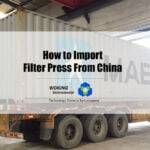Installation of filter press
1) In the installation of filter press, it’s required to check whether the concrete foundation is level and solid or not in advance . To facilitate the discharging operation, the footpath must be kept unobstructed, with a passageway about 1m in width around the filter press. The frame must be aligned with respect to the level and diagonals, and the tail plate outrigger must be anchored with the ground bolt. The cylinder outriggers require no anchoring, but shall be in smooth contact with the ground to ensure a certain free displacement when being loaded.
2) Check whether various bolts of the filter press frame are fastened, whether filter plates are arranged in order, and whether holes are aligned. In the case of open flow filter press, the liquid nozzle must be fitted at lower end of filter plate and be fastened. If the user requests the use of liquid receiving disk or turning plate, the base of the whole machine shall be higher than the foundation level by a certain volume to reserve a space for installation of liquid receiving disk or turning plate.
3) Filter plates must be arranged on the frame in order without any inclination to avoid influencing the normal operation of the filter press. The filtration fabric must be kept clean without folding, otherwise leakage may occur. Bolts of the cloth clamper, if any, must be tightened evenly, to press the filtration fabric against the charging inlet; otherwise the filter pulp may enter into the space between filtration fabric and filter plate to influence the normal operation of the filter press.
4) The mounting position of hydraulic station can be determined according to the actual conditions of the user (for part of models, the electric control box has been fitted on the frame), and the pipeline must be as short as possible, but no less than 1.5m. The hydraulic station shall be far away from the discharging place to avoid falling of materials onto the hydraulic station to influence the normal operation of hydraulic elements or the motor. Check whether connections of various oil pipelines are loosened and whether the oil tank is clean, and then fill the tank with HM46 or HM8 anti-wear hydraulic oil.
5) In case of corrosive gas user, the electric control cabinet shall be fitted in the operating room isolated from the corrosive gas to avoid damaging electric elements and influencing the normal operation (for other users, the installation can be performed as required); after it is confirmed that the power and motor are correctly wired, switch on the power supply, and check the electric control cabinet again.
6) During hoisting operation of the filter press, the place involved must be lined with cloth or other soft material.
Debugging of filter press
1) Inspection of the whole machine:
- (a) Wipe up the hydraulic station and electric control cabinet, check whether various oil pipes of the hydraulic station are correctly fitted, and whether the electric control cabinet and all electric devices are correctly wired.
- (b) Clean the frame and filter plate, and check whether filter plates are correctly arranged and whether the correct number of plates are pulled at each time; check whether the filtration fabric is folded; if any, unfold the cloth.
- (c) Check whether the charging, washing, blowing pipelines and valves are reasonably configured. For the installation of pipelines, refer to Fig.V.
2) Debugging of hydraulic system: Please refer to the hydraulic principle drawing and Annex I.
3) Debugging of electric system: Please see the electric principle drawing for the types of auto plate pulling machine.
4) Debugging of filtering part
- (a) Pressing of filter plate and pressure keeping.
- (b) Turn on all liquid discharging valves, close washing and blowing (washable types) الصمامات, open the charging valve by about one fourth, start the charging pump, and observe the pressure changes of the filtered liquid and charged materials; if the pressure is too high, turn on the valve on the return pipe for regulation. Due to the capillarity of filtration fabric, at the very beginning, the filtered liquid may be somehow turbid. Generally, in the case of open flow types, the charging valve can be further opened after the filtering operation of 3-10 minutes (in the case of undercurrent types, about 6-20 minutes). (Depending on industries, such time may be varied.)








